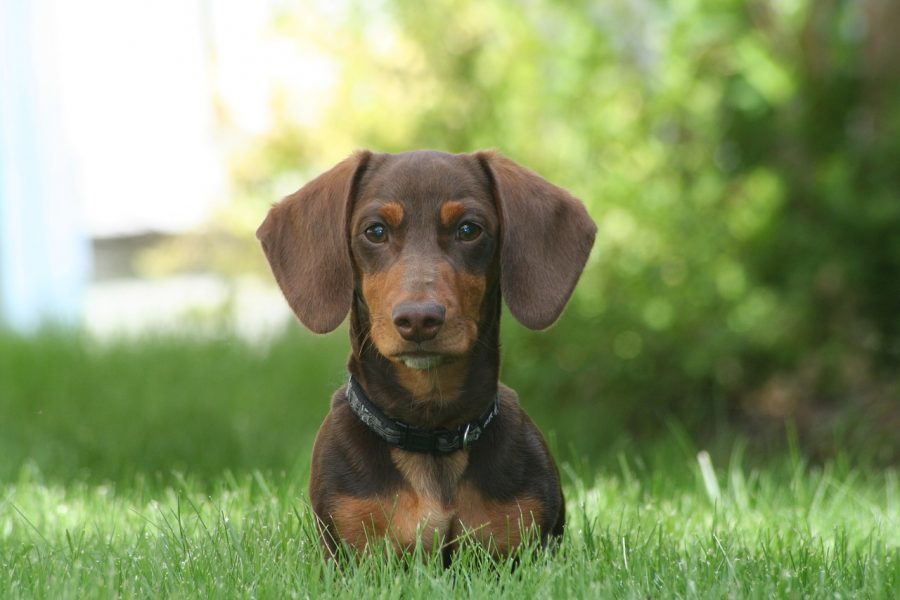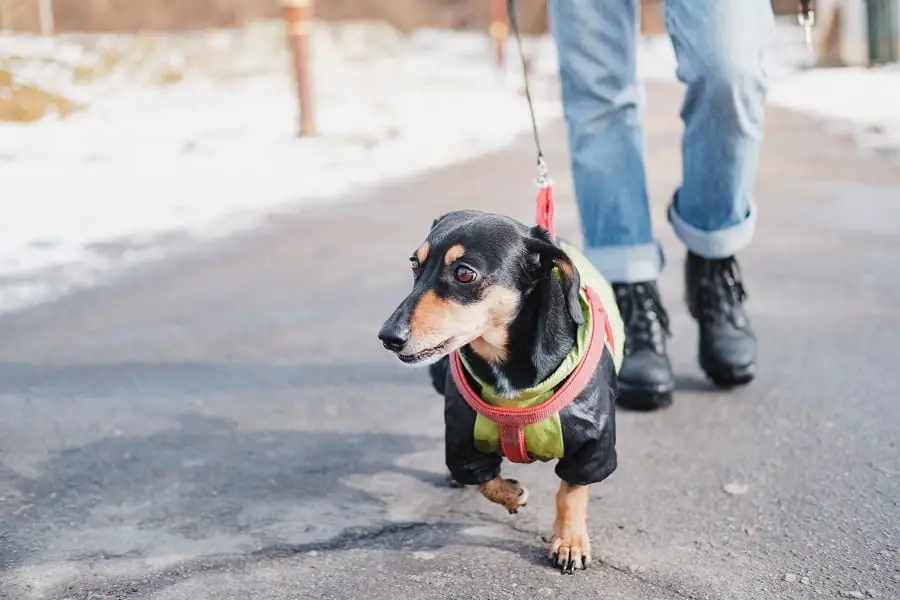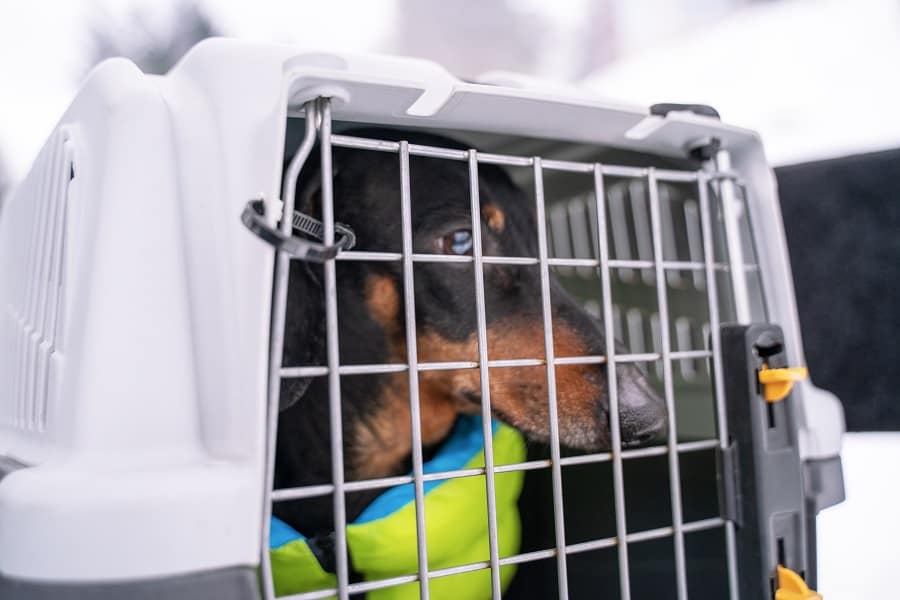Dachshunds are instantly loveable – their small bodies house big personalities, and their presence can brighten up any home. But many dog parents make the mistake of bringing a pup into their lives without proper understanding of how to train them, and with dogs as willful and independent as dachshunds, this can become problematic sooner than later.

To avoid the sad outcome of having to return your pup to a shelter or concluding that maybe you’re not a dog person after all, it’s important to be several steps ahead of your dachshund, to make sure that you create a loving, wholesome and fulfilling relationship with your doxie.
Barking
If you’re not used to living with or being around doxies, you might be surprised by how much such a small dog can bark. Before this surprise turns into frustration, it’s important to understand that these deep, booming and sometimes incessant barks are in a dachshund’s nature.
Bred as hunting dogs, their broad chests and powerful lungs are built not just to withstand attacks from sometimes-bigger animals, but also to alert their owners of their location when they’ve burrowed into the subterranean retreat of their prey.
Not to fear though – while you can’t stop your doxie from barking altogether, you can keep it under control provided you start training them, preferably early on. For starters, you need to recognize why your dog is barking – this will help address the cause of their behavior, and tackle it more decisively than to simply discipline them each time they bark.
A dachshund may be barking because they are anxious or afraid – if you scold them, this would only serve to make them afraid of you, and damage the trust between you and your pup. Rather than attempting to discipline them with harsh actions such as shouting and hitting (which you must absolutely never do with any dog in general), firmly tell your dog ‘No’ if they start barking incessantly.

Once they stop, praise them and give them a treat. As very food-motivated animals, repeated training in this way will train your dachshund, who tends to be a fast-learner, to associate being quiet to treats. Removing your dog from aggravating stimuli may also help – keep their crate in a room away from the street if you live in a busy neighborhood where traffic noises or other sounds might confuse and concern them.
Dachshunds also tend to be a suspicious breed, and if not socialized properly may start barking at strangers and other dogs, even attempting to pick fights with them. To prevent a situation where you can’t even take your dog for walks for the fear that your dachshund will start barking at anyone and everyone, it’s critical to start socializing your puppy from a young age.
Gently introducing them to new people and places when they’re younger would help raise them as friendly dogs excited to make new friends, so frequent visits to dog parks and enrolling your dachshund in a puppy kindergarten can be beneficial. Remember, dachshunds also crave company, and become anxious in isolation – if you have to work long hours, having a dog sitter over to keep your pup company can also minimize this anxiety.
Dachshunds also tend to bark when they want attention or are a bit too excited, and if you’re not careful, you might unintentionally condition them to bark more by encouraging this type of behavior by showing affection when they’re jumping all over you when you come back home, petting them or praising when they’re being noisy to get noticed, etc.
As impossible and mean as this sounds, steel your heart and ignore your pup when they are getting too rowdy from excitement or joy, and once they’ve calmed down, reward them with treats and praises. This reinforces your dog’s understanding that being calmer and quieter is a good thing; otherwise you might condition them to exhibit problematic behavior to try and get what they want.
Potty training
Dachshunds have a mind of their own, with their own idea of the rules. So, they might see absolutely nothing wrong with relieving themselves in your home and leaving you to deal with stained, stinky carpets and rugs and messes that might make you want to rip your hair out. As frustrating as this may be, it’s key to be patient and kind when attempting to potty train your puppy – after all, they don’t know any better.

Don’t scold or hit your dog, and don’t attempt to discipline them unless you’ve caught them in the act – otherwise they won’t know what it is you’re telling them not to do, and you might end up leaving them anxious and afraid of you. Instead, schedule regular bathroom breaks – take your pup out to relieve themselves after a meal or playtime, and then once they have relieved themselves give them lots of praises and rewards in the form of treats or toys.
If they relieve themselves indoors, which is an inevitability in the first few weeks of having a puppy at home, clean the place up as thoroughly as possible to remove the scent so the puppy doesn’t go back there again to do his business. If you catch them in the act, firmly tell them ‘No’, and carry them outside, letting them relieve themselves and rewarding them. The emphasis is on patience and consistency – dogs tend to feed off of the emotions of their owners, so if you’re letting on that you’re frustrated and angry, they might react negatively too.
Biting
Again, biting is in the nature of dogs, particularly a hunting breed such as the dachshund, who are primed to attack and kill. And if not trained properly, some ‘victims’ might include your furniture, shoes, pillows and even your ankles. Although the bites of young pups might be harmless and even playful, they ought to be discouraged as early as possible to prevent them from becoming problematic at a later date.
Dachshunds tend to bite when they are afraid or anxious, or as a sign of aggression. Thus, and we’ll repeat ourselves as many times as necessary for emphasis, you mustn’t scold or hit your pup, even if they’ve just destroyed your favorite pair of sneakers.
If they become afraid of you, or decide to retaliate to aggression with more aggression, this will only exacerbate the biting problem and make a dog who has the potential to be your loyal companion and cuddle-buddy into an antsy machine of destruction instead.
Discourage biting behavior by giving them lots of chew-toys – praise and reward them for using these, while firmly telling them to stop if they insist on nibbling on something they aren’t supposed to nibble on, and giving them a treat once they do.
One way of doing this is to assert your authority over your pup – dachshunds are proud, intelligent and domineering dogs and might be trying to bite and bark to assert their dominance, so by standing up every time you are about to give them a command, and using a firm, loud voice, you can let them know that you’re the leader of the pack.
Once they understand that, they’re much more likely to comply to your desires. You can also use a clicker or a can of coins to get their attention and distract them from whatever they’re attempting to bite.
Leash Training
Keeping your dachshund on a leash when going on walks is recommended, since their inquisitive and adventurous natures prime them for the hunt and they might take off as fast as their little legs will carry them if something piques their interest. To prevent your pup from accidentally hurting someone, picking a fight or getting lost, train them to stay on the leash.

Pick a well-fitted harness and leash that won’t be too tight or uncomfortable on your pup, and teach them to ‘heel’ by getting them to walk alongside you, on your left, guiding them along with a toy or a treat in your right hand. If they jog beside you at a steady pace for a few paces, gives them lots of praises and rewards.
If your pup tries to take off by themselves, stay where you are or walk in the opposite direction, without pulling the leash. Once your pup realizes you’re not about to follow, he will come back to you. With enough practice, you can enjoy plenty of pleasant walks together. In fact, at least thirty minutes of exercise is important for a dachshund each day, to keep them mentally stimulated, and prevent them from getting anxious, bored or overweight, all of which could lead to behavioral and health problems.
Crate Training
To help with your pup’s potty training, and cope with any anxiety they might be feeling when, for instance, you have guests over or aren’t at home, crate training can be the answer. The crate should be treated as a place of happy retreat for your dachshund, not as a place where they’re locked up as punishment.
With time, your dachshund will voluntarily seek out their crate when they want to play, nap or eat – as den animals, they’re naturally programmed to prefer an enclosed, clean, safe space where they don’t have to worry about threats to their territory or themselves.

Introducing a doxie to a crate at a young age can help train them to hold their bladder for longer – it’s recommended for the crate to be just big enough for your dachshund to stand and turn around comfortably in, but no bigger. This is because, if this is the amount of space available for your dachshund to sleep and play around in, they’ll be reluctant to relieve themselves in there and make a mess of it.
This will teach them to hold it in longer, and with plenty of treats and praises and regularly scheduled bathroom breaks where you take them outside to do their business, your dog will gradually learn not to soil your home every time nature calls.
Since dachshunds also exhibit high levels of separation anxiety from their humans, and it is just not feasible for them to be glued to your side all day, crates can also become a safe haven for them to relax in when you aren’t around.
Place your pup’s dog bed, one that he has already used and has his scent on it, inside the crate – if you’ve picked a crate that your pup is going to grow into, get a dog bed that fills the floor space to deter them from relieving themselves – as well as some of his favorite toys and maybe a shirt or blanket that has your scent, to assure your pup that you aren’t far away. Keep the crate, preferably one that lets your dachshund see what’s going on around them, in a place you and your family tend to hang out, so they don’t feel as though you’ve abandoned them.
Familiarize them with the crate slowly – let them investigate it on their own first, and then begin trying to persuade them into it, gradually. Offer treats and praise if they go up to the crate, then eventually when they begin venturing inside, and of course finally when they go in on their own and you can close the door. The latter should be done as casually as possible, once your pup is comfortable with being inside the crate, so as not to alarm them.
As stubborn and clingy dogs, it’s fair warning that the process might not be a walk in the park – you might have to deal with lots of protesting barks and whining when you tuck him away at bedtime. But as much as it may break your heart, stay strong – don’t let him out, otherwise he will associate being rowdy to getting what he wants.
Take him out once every couple hours outside for a bathroom break, but without any pets or praises. Once he realizes he’s not going to get his way, he’ll learn that night-time is not play-time.
